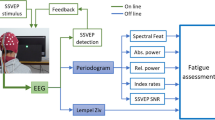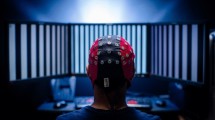Abstract
During the operation of the visual stimulated brain-computer interfaces (BCIs), users suffer fatigue when gazing at the stimulus. Loss of attention and decreased vigilance caused by fatigue impair the users’ cognitive capabilities, which consequently degrade the EEG quality and system performance. Cognitive neurodynamics measured by EEG activity are related to the generalized performance on cognitive tasks and mental efforts. Therefore, time varying EEG spectral analysis is proposed as an objective method to evaluate fatigue during the cognitive process in the visual stimulated BCIs. The results shows that the increase in θ, α and (θ + α)/β, as well as the decrease in θ/α are associated with the increasing fatigue level during the cognitive process.
Access provided by Autonomous University of Puebla. Download conference paper PDF
Similar content being viewed by others
Keywords
1 Introduction
Brain-computer interface (BCI) is a technology that provides a direct communication pathway between the brain and an external device which is independent of normal peripheral nervous and muscular systems [1]. Visual stimulation is the most commonly used input for practical BCI systems. However, the user of visual stimulated BCI usually claims vision fatigue. For example, steady-state visual evoked potential (SSVEP) requires the user to gaze at flashing stimuli, resulting in discomfort and tiredness, and consequently reduce the performance. Especially for stimuli with high brightness and contrast, users will easily feel extremely drowsy and have difficulty in concentration. SSVEP-based BCI, as an attention dependent system, requires significant effort to focus on the flashing stimuli to produce sufficiently strong SSVEP signals, and the users may easily get fatigue. The cognitive neurodynamics process of the visual system responding to an SSVEP signal is easily affected by various mental states, attention, fatigue and so on [2, 3]. Loss of attention caused by fatigue will reduce the cognitive performance, consequently reduce the SSVEP quality and system performance. There is a real demand to establish an objective and online assessment to evaluate the fatigue during cognitive process in SSVEP-based BCIs.
Previous studies proposed several questionnaires or subjects’ description to indicate the fatigue degree [4–7]. However, they are quit raw, subjective, inaccurate and difficult in on-line measurement. Cognitive neurodynamics measured by EEG activity are related to generalized performance on cognitive tasks and mental efforts. More specifically, the low cognitive capacity and decreased arousal level are associated with global increase in θ and α [8–10]. Therefore, the dynamic change of EEG activity would be an indicator for fatigue. Time varying EEG spectral in theta and alpha activity is proposed as an objective method to evaluate fatigue during cognitive process in SSVEP-based BCIs.
2 Methods
An LCD monitor was used as the visual stimulator (ViewSonic 22″, refresh rate 120 Hz, 1,680 × 1,050 pixel resolution) and the stimulus was programmed under Microsoft Visual Studio 2010 using Microsoft DirectX SDK (June 2010). There was a symbol “+” in the center of the flashing stimulus to keep the subjects focusing on the target. The stimulus was flashing for 3 s for 30 trials, and 2 s pause was set between each trial. EEG was collected from Oz channel by an amplifier (g.USBamp, Guger Technologies, Graz, Austria) and were filtered by a 50 Hz notch filter and a 0.5–60 Hz band-pass filter. The amplitude of frequency bands δ, θ, α and β were calculated in each trial by using fast Fourier transforms (FFT). The average amplitude of each frequency band was selected as an index of this frequency band, and was used to calculate the EEG ratio indices θ/α and (θ + α)/β. Eleven subjects (aged from 22 to 28 years old, six males and five females) participated in the experiments and were asked to complete a validate self-reported fatigue questionnaire before and after the task work, which was called the Chalder Fatigue Scale (CFS) [11]. The CFS had high reliability and validity, and it was used in this study as a standard reference for fatigue levels. A linear regression analysis was employed to compare the association of EEG indices and fatigue states.
3 Results
The CFS score was significantly increased (p < 0.001) with pre-mean CFS score = 14.91, standard deviation (SD) = 1.22; post-mean CFS score = 25.73, SD = 4.98; which indicated the fatigue level was significantly increased after SSVEP-based BCI experiments. For the EEG evaluation of fatigue, it would find the strong association between CFS and the EEG indices θ and α, as well as ratio indices θ/α and (θ + α)/β. Figure 1 presented the average value over all subjects for time varying EEG indices θ and α, as well as ratio indices θ/α and (θ + α)/β, which demonstrated the dynamic prediction for fatigue during cognitive process. The results indicated significant correlations between EEG indices in θ, α and the number of trials, with the R 2 values equal to 0.68 (p < 0.001) and 0.77 (p < 0.001), respectively. Both the ratio indices θ/α and (θ + α)/β were found significantly correlated with the number of trials, with the R2 values equal to 0.60 (p < 0.001) and 0.78 (p < 0.001) respectively. Therefore, these results suggest that the increase in θ, α and (θ + α)/β, as well as the decrease in θ/α are associated with the increasing fatigue level during cognitive process.
4 Conclusion
The time varying EEG spectral analysis is proposed as an objective approach to evaluate fatigue during cognitive process in SSVEP-based BCIs. The proposed approach can provide a real-time evaluation of the fatigue with objective and quantitative measurement. The promising result suggests the potential of objective evaluation of fatigue by dynamic measurement in EEG indices θ and α, as well as ratio indices θ/α, (θ + α)/β. The time varying EEG activity would predict the fatigue immediately, which may provide a useful online assessment of fatigue. The increase in θ, α and (θ + α)/β, as well as the decrease in θ/α are associated with the increasing fatigue level during cognitive process. In addition, this method can be used for optimal selection of visual stimuli parameters (e.g., visual stimulus frequency, duty cycle, color, etc.) to design a user-friendly BCI system, which cause less fatigue in further study.
References
Wolpaw J R, Birbaumer N, McFarland D J, Pfurtscheller G and Vaughan T M 2002 Brain-computer interfaces for communication and Control Clin. Neurophysiol. 113 767–91
Eriksen C W and James J D S 1986 Visual attention within and around the field of focal attention: a zoom lens model Percept. Psychophys. 40 225–40
Yamaguchi S, Tsuchiya H and Kobayashi S 1994 Electrooencephalographic activity associated with shifts of visuospatial attention Brain 117 553–62
Allison B, Lüth T, Valbunena D, Teymourian A, Volosyak I and Gräser A 2010 BCI demographics: how many (and what kind of) people can use an SSVEP BCI? IEEE Trans. Neural Syst. Rehabil. Eng. 18 107–16
Bieger J and Molia G G 2010 Light stimulation properties to influence brain activity: a brain-computer interface application Philips Research Technical Note TN-2010-00315
Volosyak I, Valbuena D, Lüth T, Malechka T and Gräser A 2011 BCI demographics II: how many (and what kind of) people can use a high-frequency SSVEP BCI? IEEE Trans. Neural Syst. Rehabil. Eng. 19 232–9
Allison B Z, Brunner C, Altstätter C, Wagner I C, Grissmann S and Neuper C 2012 A hybrid ERD/SSVEP BCI for continuous simultaneous two dimensional cursor control J. Neurosci. Methods 209 299–307
Lehmann D, Grass P and Meier B 1995 Spontaneous conscious covert cognition states and brain electric spectral states in canonical correlations Int. J. Psychophysiol. 19 41–52
Klimesch W 1999 EEG alpha and theta oscillations reflect cognitive and memory performance: a review and analysis Brain Res. Rev. 29 169–195
Lafrance C and Dumont M 2000 Diurnal variations in the waking EEG: comparisons with sleep latencies and subjective alertness J. Sleep Res. 9 243–8
Chalder T, Berelowitz G, Pawlikowska T, Watts L, Wessely S, Wright D and Wallace E P 1993 Development of a fatigue scale J. Psychosom. Res. 37 147–53
Acknowledgments
This work was supported in part by the Macau Science and Technology Development Fund (Grant FDCT/036/2009/A) and the University of Macau Research Fund (Grants MYRG2014-00174-FST, MYRG139(Y1-L2)-FST11-WF, MYRG079(Y1-L2)-FST12-VMI and MYRG069(Y1-L2)-FST13-WF).
Author information
Authors and Affiliations
Corresponding author
Editor information
Editors and Affiliations
Rights and permissions
Copyright information
© 2015 Springer Science+Business Media Dordrecht
About this paper
Cite this paper
Cao, T., Wong, C.M., Wan, F., Hu, Y. (2015). Time Varying VEP Evaluation as a Prediction of Vision Fatigue Using Stimulated Brain-Computer Interface. In: Liljenström, H. (eds) Advances in Cognitive Neurodynamics (IV). Advances in Cognitive Neurodynamics. Springer, Dordrecht. https://doi.org/10.1007/978-94-017-9548-7_21
Download citation
DOI: https://doi.org/10.1007/978-94-017-9548-7_21
Published:
Publisher Name: Springer, Dordrecht
Print ISBN: 978-94-017-9547-0
Online ISBN: 978-94-017-9548-7
eBook Packages: Biomedical and Life SciencesBiomedical and Life Sciences (R0)





